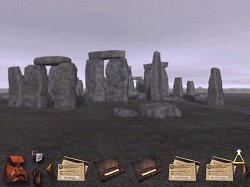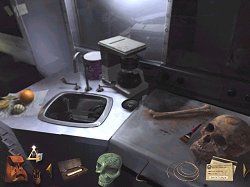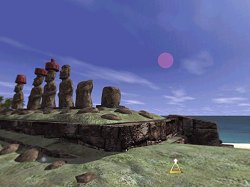|
The Omega Stone: Riddle of the Sphinx II
 The year is 2012 and some remarkable events are about to unfold. It is the year that the normally accurate Mayans may have predicted for the end of the world, and given that there are plans afoot to turn Stonehenge into a theme park it could be argued that civilisation as we know it is about to come to an end. Yet this economic rationalist-inspired piece of cultural vandalism rivalling that of the wanton destruction of the Bamiyan Buddhas may soon be overshadowed by the more immediate threat of a comet hurtling towards the Earth. Could the Mayans have had access to some ancient knowledge that presently eludes us?
In this sequel to Riddle of the Sphinx more riddles are posed and some even answered as you travel the globe seeking clues in and around ancient sites that seem to be linked in some mysterious way. Once again the redoubtable Sir Gil Blythe Geoffreys is on hand to explain the significance of his discoveries and send you on your way to find the stone discs that just may help to save the planet. And even though the game isn't timed, the sense of urgency is conveyed through references in a newspaper and in the notes Gil leaves for you and, most dramatically, in the need for you to commit your own piece of cultural vandalism in order to progress. I must admit that I found this act quite disturbing and wished there was an alternative solution. Though in the context of the impending destruction of everything if you fail in your mission, I suppose the end justifies the means. The year is 2012 and some remarkable events are about to unfold. It is the year that the normally accurate Mayans may have predicted for the end of the world, and given that there are plans afoot to turn Stonehenge into a theme park it could be argued that civilisation as we know it is about to come to an end. Yet this economic rationalist-inspired piece of cultural vandalism rivalling that of the wanton destruction of the Bamiyan Buddhas may soon be overshadowed by the more immediate threat of a comet hurtling towards the Earth. Could the Mayans have had access to some ancient knowledge that presently eludes us?
In this sequel to Riddle of the Sphinx more riddles are posed and some even answered as you travel the globe seeking clues in and around ancient sites that seem to be linked in some mysterious way. Once again the redoubtable Sir Gil Blythe Geoffreys is on hand to explain the significance of his discoveries and send you on your way to find the stone discs that just may help to save the planet. And even though the game isn't timed, the sense of urgency is conveyed through references in a newspaper and in the notes Gil leaves for you and, most dramatically, in the need for you to commit your own piece of cultural vandalism in order to progress. I must admit that I found this act quite disturbing and wished there was an alternative solution. Though in the context of the impending destruction of everything if you fail in your mission, I suppose the end justifies the means.
 As with the first game this is a fascinating journey that allows an up-close exploration of some of the ancient wonders that clearly still inspire and intrigue us. The Omega Stone is an imaginative tale that is more ambitious than its predecessor and manages to weave into the story a shadowy brotherhood that seems to have links to the Templars and hints at further ambiguous, if not sinister motives. Needless to say we will have to wait for the next game to see how this web of intrigue pans out. In the meantime we get to count like the Mayans as we decipher glyphs and puzzles in the labyrinthine tunnels beneath Chitchen Itza; practice a little alchemy in a mysterious Celtic land that seems strangely shifted out of time; explore the ocean depths that is a graveyard for ships and planes; walk amongst the haunting megaliths of Stonehenge and gaze enigmatically alongside the statues of Easter Island ... but not for ever ... there is still a world to be saved.
And there is much work to be done for the past does not yield up its treasures easily. It's up to you to explore and find and interpret the clues that will enable you to move on. You really do need to use your head and a number of others that you will pick up along the way. The puzzles are in context and generally fair as long as you are observant and read everything carefully. Letters, books and journals can provide clues as well as advance the story, though I must admit that I had a little trouble deciphering some handwriting and I was guessing at the numerical value of some crucial Mayan glyphs that became blurred at one extremity. As with the first game this is a fascinating journey that allows an up-close exploration of some of the ancient wonders that clearly still inspire and intrigue us. The Omega Stone is an imaginative tale that is more ambitious than its predecessor and manages to weave into the story a shadowy brotherhood that seems to have links to the Templars and hints at further ambiguous, if not sinister motives. Needless to say we will have to wait for the next game to see how this web of intrigue pans out. In the meantime we get to count like the Mayans as we decipher glyphs and puzzles in the labyrinthine tunnels beneath Chitchen Itza; practice a little alchemy in a mysterious Celtic land that seems strangely shifted out of time; explore the ocean depths that is a graveyard for ships and planes; walk amongst the haunting megaliths of Stonehenge and gaze enigmatically alongside the statues of Easter Island ... but not for ever ... there is still a world to be saved.
And there is much work to be done for the past does not yield up its treasures easily. It's up to you to explore and find and interpret the clues that will enable you to move on. You really do need to use your head and a number of others that you will pick up along the way. The puzzles are in context and generally fair as long as you are observant and read everything carefully. Letters, books and journals can provide clues as well as advance the story, though I must admit that I had a little trouble deciphering some handwriting and I was guessing at the numerical value of some crucial Mayan glyphs that became blurred at one extremity.
 As there is a lot to see and do you might want to use the camera that is part of the interface to take snapshots of significant stone markings or pages of books to save having to travel back and forth to read them. Even with this useful feature Rosemary and I still made copious notes and diagrams on sheets of paper. There are many items to pick up and carry around and for the most part (red herrings aside) they clearly have a specific use either to provide information or to be used in a particular location. The hitch is that your inventory very quickly becomes cluttered and I could find no way to drop items that I knew were no longer needed. If you are stuck you will need to carefully contemplate your inventory, explore some more or think about all that you have learned about the location you are in. The stones themselves could be trying to tell you something.
It is possible to die, though this is not a constant threat. It happened to me only once and it was quite a shock, but it did provide a valuable clue. I should also mention that there is a genuine maze in this game though it is not too arduous to negotiate. As there is a lot to see and do you might want to use the camera that is part of the interface to take snapshots of significant stone markings or pages of books to save having to travel back and forth to read them. Even with this useful feature Rosemary and I still made copious notes and diagrams on sheets of paper. There are many items to pick up and carry around and for the most part (red herrings aside) they clearly have a specific use either to provide information or to be used in a particular location. The hitch is that your inventory very quickly becomes cluttered and I could find no way to drop items that I knew were no longer needed. If you are stuck you will need to carefully contemplate your inventory, explore some more or think about all that you have learned about the location you are in. The stones themselves could be trying to tell you something.
It is possible to die, though this is not a constant threat. It happened to me only once and it was quite a shock, but it did provide a valuable clue. I should also mention that there is a genuine maze in this game though it is not too arduous to negotiate.
Even though The Omega Stone, like its predecessor, is a game of solitary exploration you will meet some other characters. First there is Gil, of course, who is the Alpha and the Omega in that he delivers the introductory monologue that brings you up to speed and winds up the game by explaining some of what you and he have learned. Then there is 'Hump' who takes you where you need to go but isn't a great conversationalist. You will also meet Gil's eccentric colleague Lord Bathelwaite who will fill you in on some details providing you can find the key to enter his Manor. Oh and there is also a rather bewildered-looking druid lurking around somewhere. Even young Christian Troy who doesn't appear has a decidedly real 'presence' in the writings and detritus of his life that he leaves behind. As there is no text option you will need to listen carefully to what Gil and Bathelwaite tell you. Some captioning would have invited more players to enjoy this trip.
The graphics are generally improved over the first game with smoother integration and only a slight graininess noticeable at certain times such as in Lord Bathelwaites study. Though the screens are largely static - water doesn't flow, no breeze ruffles the trees - the music and sound effects help to overcome this omission. They blend in well with the game and help immensely to create the atmosphere, especially in the underground tunnels and the eerie nighttime scenes of the Celtic cemetery and surrounds. I had to turn up the brightness of my monitor for underground exploration and I think that the resolution could have been sharper, especially when it came to reading the various texts and deciphering glyphs. I tried the game on two PCs, one with a 32MB video card and one with 64MB, and there was no discernable improvement.
I should point out that this didn't spoil my enjoyment of the game as it was good enough to carry some shortcomings in this department. In fact in the case of the blurry glyphs, they had the effect of enhancing the realism. When deciphering ancient stone glyphs I would expect some deterioration in clarity. Playing on the low end PC (PIII 500Mhz with 128MB RAM) there were some long load times between locations that were completely eliminated on our faster PC (P4 2.4Mhz with 256MB RAM).
Navigation is a breeze and everything is mouse controlled. Some useful options are provided that enable you to set the panning speed, choose fixed or free cursor, or even let the cursor provide more or less help. Occasionally the cursor doesn't indicate a crucial hotspot but in these instances they are fairly obvious. You can also choose the gender of your character and this changes how you are acknowledged in the game. For example if you choose to play as a female then a letter will address you as 'Madame' and Gil refers to you as 'she' and 'her' in a letter to Bathelwaite. Small touches, but very welcome just the same. I was also pleased to see that an explanation of sorts was forthcoming concerning the anachronism of the artefact discovered beneath the Sphinx at the end of the last game. Though I still feel that the significance of a Biblical artefact in relation to monuments and civilisations that largely pre-date Biblical times strikes a discordant note. I'm intrigued as to where this story is leading and I guess I will just have to wait for the next game to find out.
Rosemary and I generally try to play adventure games together and often the measure of a game for us is how quickly we both become engrossed in it. From the very start when we collected some fascinating scrolls and set about working out the clues of the hieroglyphics, we were enthusiastic. Exploring the tunnels of Chitchen Itza and discovering more mysterious writing and many equally mysterious artefacts heightened this enthusiasm. We enjoyed it immensely, particularly solving the alchemy puzzle towards the end. This puzzle took some time as it drew together multiple clues and it gave us a real sense of achievement.
Although it is a sequel to the Riddle of Sphinx you could play this game without having played the first, although it will probably entice you into getting hold if it. The Omega Stone comes on 4 CDs and if you have the room to install the lot to hard disk you can eliminate disk swapping.
Note: Since writing this review a patch has been released that addresses a number of issues including the blurry glyph and the general darkness. Download the patch from The Adventure Company.
Copyright © Gordon Aplin 2003.
All rights reserved.
System Requirements:
Windows 95/98/ME/2000/XP
Pentium II 300 MHz processor or higher
64 MB RAM (128 MB recommended)
12x Speed CD-ROM drive
Direct X Compatible Video Card (16 MB recommended)
Direct X Compatible Sound Card, Mouse
|

